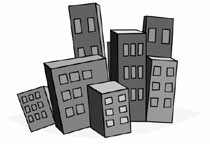Throughout history, architects and builders have designed and erected shelters that protect us both at work and home. Influenced by the cultural needs of the time period, architecture is essentially the art we live in.
Back in the 1800’s, architects began incorporating steel into their designs to allow for taller structures, and hence, the skyscraper was born! During this tall-building boom, architect Louis Henri Sullivan was known for the principle of “form follows function” and instrumental in creating a new functional design for these new tall buildings. While working under Sullivan for six years, Frank Lloyd Wright cited him as being a major influence in Wright’s minimalistic, streamlined style and approach of incorporating nature into his architectural designs. The importance in the underlining function of the design prevails!
Today, architectural design of office buildings has taken on a new dimension by incorporating technology into its design to manage the overall function of a structure. New designs use the Internet as a scaffold to support and transmit information within its structure. With the rise of smart devices and how the Internet of Things (IoT) brings together devices, sensors, cloud, and data, builders are taking “smart” to a whole new level, with smart buildings rising across the world. These new smart buildings benefit both business and the environment.
Smart benefits for business
Smart construction utilizes a networked ecosystem of “smart” building equipment and devices, and has proven to save energy. Thus, they reduce expenses to building facilities and increase savings to a company’s bottom line. Incorporating windows that absorb daylight and buildings that spin around to get the best solar exposure is very cost effective. These windows can be integrated with building automation systems and programmed, along with other building equipment, to utilize natural sunshine and heat to offset the need for artificial lighting and artificial heating from HVAC. Smart lighting systems can respond to the availability of natural light and the presence of occupants. One of our team members experienced this first hand on a recent trip to Europe when she left her tablet and smartphone charging in the hotel. (Or, so she thought.) Unbeknownst to her, when she left the room the lights and power automatically turned off. Imagine her surprise when she returned only to find the devices still void of charge. The research firm ON World predicts that, by 2020, 100 million Internet-connected wireless light bulbs and lamps will be installed to both save energy and improve workplace functionality.
Smart technology opens new avenues for how humans, machines and buildings can interact. Imagine… You arrive at your workplace, park your car in the automated garage, use a retinal scan to pass security, and by the time you walk into your office, everything is ready for you—computer, lights and temperature already set for you to begin your workday. These integrated systems of connected devices with machine-to-machine communication and cloud technology are automating the way we live and work.
Smart benefits for the environment
Public interest in sustainability has triggered a surge of green building innovation. Increased water concerns and energy costs have sparked resource-efficient building operations among commercial businesses. New regulations in many states provide further motivation in the form of energy disclosure ordinances or tax incentives for sustainable construction and building operations.
Research has shown that green buildings are good for employee health and well-being. Utilizing air-cleaning paint reduces harmful emissions in power plants and factories, by interacting with light to break down harmful gases into harmless substances. This same technology prevents the growth of mold, algae and bacteria. Corporate tenants are willing to pay higher rents for the resulting workplace productivity gains, while employees and consumers alike prefer companies that are socially and environmentally responsible.
Smart construction is not the stuff of science fiction. The technology is out there today! Buildings where lighting, air conditioning, security and other systems pass data freely back and forth—leading to higher efficiency, more safety and comfort, and lower cost operation of the facility are here today. As a continued effort to help the planet, reduce energy consumption of older equipment, and safely recycle electronic waste, we invite you to participate in RED Month. During the month of November, IT Radix offers free recycling to all of our IT Radix clients. Learn more at www.it-radix.com/red.
First published in our November 2015 IT Radix Resource newsletter
[code-snippet name=”disable-blog-feature-image”]


